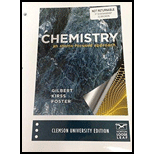
To find:
The concentration of carbonate
Answer to Problem 15.106QA
Solution:
The concentration of carbonate ions in the water sample is
Explanation of Solution
1) Concept:
We are asked to find concentrations of carbonate
In the first stage, after the addition of the titrant, the carbonate ions present in the sample are converted into bicarbonate ions at the first equivalence point.
The reaction continues until all the carbonate ions are has been converted into bicarbonate ions. This is the first equivalence point in the titration. In the second stage of titration, the bicarbonate ions formed in the first stage plus any bicarbonate ions present in the original sample react with the additional titrant, forming carbonic acid,
According to the stoichiometry of the reactions, it takes 1 mole of
2) Formula:
3) Given:
i) Volume of sample =
ii) Volume of
iii) Molarity of
iv) Volume of
v) The alkalinity of water is due to carbonate
4) Calculations:
Calculating concentrations of carbonate
Therefore, the concentration of carbonate is
These moles of carbonate are converted to an equal number of moles of bicarbonate at the first equivalence point. The solution now contains these moles plus the moles of bicarbonate already present in the spring water sample. These correspond to the titration from the first to the second equivalence point, i.e., to the addition of another 10.42 mL of the acid. The total bicarbonate moles are then calculated as
Of these,
The concentration of bicarbonate in the sample is then calculated as
Conclusion:
The volume required for the second equivalent point is three times that for the first equivalence point. This is consistent with the observed concentrations of carbonate and bicarbonate ions as the concentration of bicarbonate ions is three times that of the carbonate ions.
Want to see more full solutions like this?
Chapter 15 Solutions
Chemistry: An Atoms-Focused Approach
- For the condensation reaction between Alamine and histamine, please help me write the amididation reaction mechanism. Then write the three letter code for the product of the reaction, then write the one letter code for the product of the reaction. arrow_forwardHow to draw the reaction mechasnism belowarrow_forwardName the following molecules with IUpacarrow_forward
- What is the molecular orbital for cyclopropenyl anion and is it aromatic, antiaromatic or nonaromatic?arrow_forwardUsing the chart describe the change from cystine to tyrosine and its impact on the protein. Using the chart describe the change from histidine to aspartic acid and its impact on the protein.arrow_forwardHow to get the predicted product of this reaction belowarrow_forward
- Please help me fill out the chart then using the chart describe the change from cystine to tyrosine and its impact on the protein. Then using the chart describe the change from histidine to aspartic acid.arrow_forwardWrite the Esterification reaction mechanism for acetic acid, and one propanol to make propanol ethanoate (molecule that gives peas its odor in flavor)arrow_forwardProvide solutionsarrow_forward
 ChemistryChemistryISBN:9781305957404Author:Steven S. Zumdahl, Susan A. Zumdahl, Donald J. DeCostePublisher:Cengage Learning
ChemistryChemistryISBN:9781305957404Author:Steven S. Zumdahl, Susan A. Zumdahl, Donald J. DeCostePublisher:Cengage Learning ChemistryChemistryISBN:9781259911156Author:Raymond Chang Dr., Jason Overby ProfessorPublisher:McGraw-Hill Education
ChemistryChemistryISBN:9781259911156Author:Raymond Chang Dr., Jason Overby ProfessorPublisher:McGraw-Hill Education Principles of Instrumental AnalysisChemistryISBN:9781305577213Author:Douglas A. Skoog, F. James Holler, Stanley R. CrouchPublisher:Cengage Learning
Principles of Instrumental AnalysisChemistryISBN:9781305577213Author:Douglas A. Skoog, F. James Holler, Stanley R. CrouchPublisher:Cengage Learning Organic ChemistryChemistryISBN:9780078021558Author:Janice Gorzynski Smith Dr.Publisher:McGraw-Hill Education
Organic ChemistryChemistryISBN:9780078021558Author:Janice Gorzynski Smith Dr.Publisher:McGraw-Hill Education Chemistry: Principles and ReactionsChemistryISBN:9781305079373Author:William L. Masterton, Cecile N. HurleyPublisher:Cengage Learning
Chemistry: Principles and ReactionsChemistryISBN:9781305079373Author:William L. Masterton, Cecile N. HurleyPublisher:Cengage Learning Elementary Principles of Chemical Processes, Bind...ChemistryISBN:9781118431221Author:Richard M. Felder, Ronald W. Rousseau, Lisa G. BullardPublisher:WILEY
Elementary Principles of Chemical Processes, Bind...ChemistryISBN:9781118431221Author:Richard M. Felder, Ronald W. Rousseau, Lisa G. BullardPublisher:WILEY





